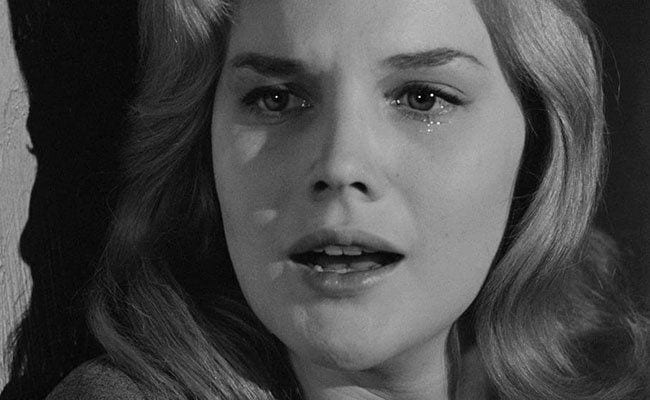
Something Wild (1961) is a disturbing, uncomfortable, beautifully shot film that largely goes nowhere. This is a sad fact, considering that the film begins so compellingly.
This sad tale of sexual assault, post-traumatic stress disorder, dejection and repulsion is immediately gripping and engrossing as a perfectly ordinary, nice and sympathetic young college student (Carroll Baker’s Mary Ann Robinson) is grabbed on campus, brutally raped and left behind like garbage. The traumatized girl doesn’t report the rape to the police or her family, but cannot adjust to her normal life again. Even her very bed feels unwelcoming and terrifying in a strange piece of symbolism. She showers, cuts up her underclothes into confetti, and attempts to avoid thinking about what happened.
The audience is immediately drawn into her distressing tale as it ‘ almost impossible not to feel for this innocent girl, dragged into a world she never chose and lacks the strength to face. As a study of trauma and survival, this psychological thriller is immediately engrossing.
This is especially true considering the quality acting given by both Baker and Mildred Dunnock (portraying Marry Ann’s mother). As Mary Ann’s optimistic socialite mother grows concerned about the world of dirty people encroaching on their own ivory tower-like home life, the already damaged Marry Ann responds “Everyone is Dirty!”
Having had her world already destroyed (albeit secretly), Mary Ann ignores her mother’s warning not to go out at night and, in fact, rejects her entire life in order to embrace something new on her own. This is, of course, Mary Ann running away from her trauma, though it continues to chase her. The character study abruptly ends, at least in the same vein that we have experienced it thus far, when Mary Ann flees her pain in order and moves to New York City (causing her mother to report her as a missing person).
As Mary Ann surrounds herself with those that her mother would certainly describe as “dirty people”, she attempts to put herself back together and fails. Life becomes a nightmare with an unsympathetic co-worker played by Doris Roberts, a sleazy landlord played by Martin Kosleck and a prostitute neighbor played by Jean Stapleton. Yes, Edith Bunker from All in the Family plays a New York prostitute in Something Wild — that’s sadly typical of the type of roles available to female actors in the ’50s and ’60s.
Unlike this film’s 1986 namesake, there’s nothing truly wild, fun or funny in Something Wild. As the film proceeds through its tale of suicide attempts, new horrors, captivity, psychosis and twisted acceptance, the audience can be forgiven for wanting some kind of justice or, at least, positive resolution, but there is none to be had here, truly. Whatever deeper meaning Garfein (as writer and director) attempted to present from Alex Karmel’s novel Mary Ann (if any) is never becomes clear.
If the true intent of the film is to illustrate that life is not fair or that we can find comfort even if it’s forced upon us, this lesson is unlearned as the film never illustrates this until the last seconds. If Garefin’s plan was to leave things ambiguous (which can, of course, work very well in some cases), this too is unsuccessful, as Something Wild ultimately comes off as incomplete and, perhaps even misogynistic and mean-spirited. This is hardly a satisfying result for a film that begins with a violent and traumatizing sexual assault. Is that the point? If so, again, this is largely unearned as the meandering second half has no valid basis for such injustice and, if anything, seems to excuse its first half with a “therapy” best described as “Stockholm Syndrome”.
Much of this could conceivably be chalked up to different attitudes, social mores and filmmaking styles of the early ’60s. However, upon researching this film, contemporary commentary commonly also reflected confusion and mixed responses. To be sure, Something Wild was controversial with its shocking subject matter, violence, and brief nudity, but so these things push forward a deep symbol or meaning? or are they simply prurient inclusions into a post-Psycho filmscape?
I would like to say that some satisfaction is offered by the almost always rich treasure trove of The Criterion Collection’s bonus features, however, these prove to be rather slim in this case. With no commentary (although the disc contains multiple audio interviews) no insight is given into the mind of this well-known director and lecturer’s final film. The Blu Ray also contains an essay by critic Sheila O’Malley and an episode of Master Class featuring Garfein.
The Criterion Collection is lauded for its commemoration of great films with a museum’s worth of extras to make the purchase worthwhile to aficionados and film students alike, but lately it seems to be putting less effort into its products. The sparse extras alone raise questions about The Criterion Collection’s reputation of late, and most of its recent releases don’t even include subtitles or closed captioning of any kind. In this day and age with international viewers, there’s no excuse for such an omission from such a lauded company.
Of course, bonus features are meant only to enhance the film itself, not to be the main attraction for Blu-ray buyers (though these extras are commonly the last real reason to buy a disc as opposed to streaming video), but aside from being largely unreleased and unscreened for many years, there seems to be no criteria here for Something Wild to have been immortalized in The Criterion Collection in the first place. This, coupled with the mostly bare-bones programming make for a $39.95 cover price that is rather difficult to justify.


![Call for Papers: All Things Reconsidered [MUSIC] May-August 2024](https://www.popmatters.com/wp-content/uploads/2024/04/all-things-reconsidered-call-music-may-2024-720x380.jpg)



